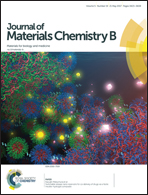A reusable and naked-eye molecular probe with aggregation-induced emission (AIE) characteristics for hydrazine detection†
Abstract
We report a fluorogenic probe for naked-eye sensing of hydrazine in solution and in the gaseous phase. The probe based on tetraphenylethylene (TPE) with aggregation-induced emission (AIE) characteristics shows OFF–ON fluorescence as observed by thin-layer chromatography (TLC) upon treatment with hydrazine. Specifically, the fluorescence of the probe was quenched due to the attached N![[double bond, length as m-dash]](https://www.rsc.org/images/entities/char_e001.gif) N group, which can be reduced to –NH–NH– in the presence of hydrazine to turn on the fluorescence. The reduced intermediate can be easily oxidized in air to regenerate the original probe for recyclable usage. Both fluorometric and colorimetric readings were achieved by TLC with high sensitivity and excellent selectivity. This study thus represents a simple example of a reusable and naked-eye molecular probe for monitoring environmental hazards. Finally, the probe has also been applied to detect hydrazine in live cells.
N group, which can be reduced to –NH–NH– in the presence of hydrazine to turn on the fluorescence. The reduced intermediate can be easily oxidized in air to regenerate the original probe for recyclable usage. Both fluorometric and colorimetric readings were achieved by TLC with high sensitivity and excellent selectivity. This study thus represents a simple example of a reusable and naked-eye molecular probe for monitoring environmental hazards. Finally, the probe has also been applied to detect hydrazine in live cells.

- This article is part of the themed collection: Celebrating Excellence in Research: 100 Women of Chemistry


 Please wait while we load your content...
Please wait while we load your content...